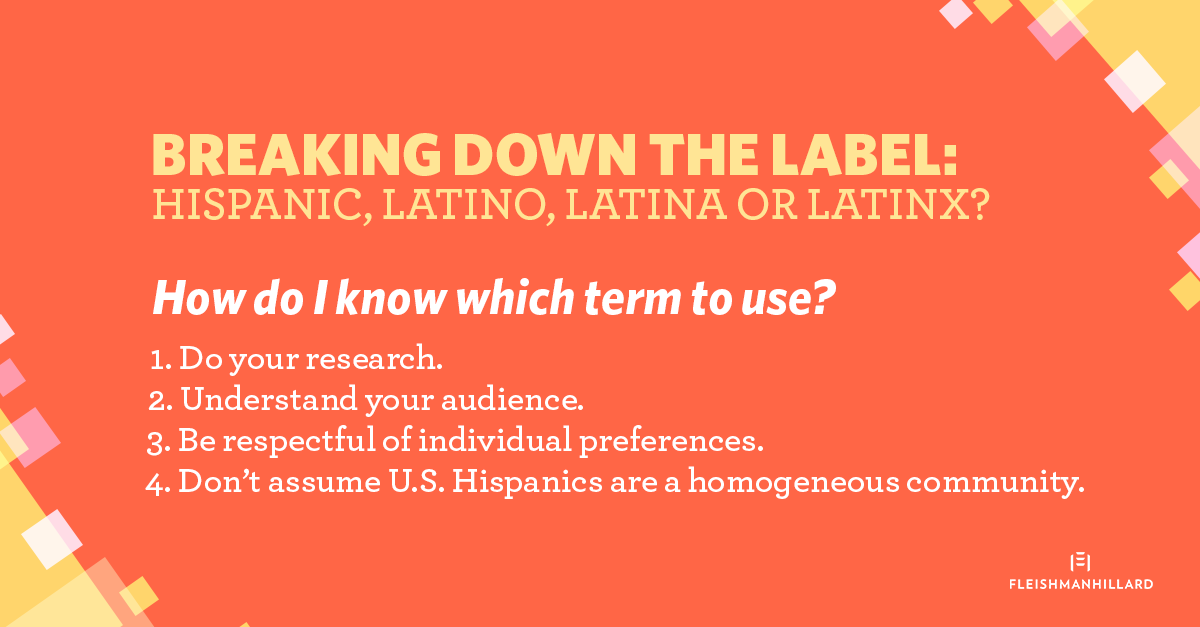Breaking Down the Label: Hispanic, Latino, Latina or Latinx?
As a young girl, when friends would ask me “where are you from?” I’d respond, “I’m Cuban.” Until one day, my mother – a Cuban exile who fled the island at 17 years old to escape Fidel Castro’s dictatorship – heard me and quickly corrected me. “Amelia, you’re not Cuban. You are Cuban-American.” As a child, I struggled to understand the difference, but I abided and listened to my mother.
Growing up, I reflected on my label of “Cuban-American” and my mother’s fervent correction. Over time I internalized the great pride my parents and grandparents held with the badge of calling oneself an “American.” Much of my family fled Cuba, an experience filled with trauma and the hope of seeking freedom as U.S. citizens. The title of “American” did not come easy, which explains why my mother wanted to ensure I didn’t default to only Cuban or American – but as a U.S.-born Hispanic. It was my first revelation about the experience Hispanics, Latinos and Latinas like me encounter when trying to label ourselves.
Today, in a world of evolving and increased conversation of inclusivity in talk and practice, brands are scratching their heads on what is best when speaking to the U.S. Hispanic consumer. Is it Hispanic, Spanish, Latino or Latina, or more recently, Latinx?
Unfortunately, there is no straight answer. The truth is, how a U.S.-born Hispanic self-identifies is deeply personal. For me, Hispanic or U.S. Hispanic always sufficed. Why? I speak Spanish, and my ancestry stems from Cuba and Spain. But those factors may not completely determine the appropriate label or individual preference for others.
Most recently, across media, pop culture and academia, Latinx is becoming more prevalent as a gender-neutral, nonbinary and inclusive alternative to Latino and Latina. The term has gained momentum and praise, especially within the LGBTQIA+ communities. Today, it’s primarily adopted by U.S. millennials and Gen Z’ers, with few older Hispanics or those outside the United States claiming the moniker.
But the relatively new term comes with its own bit of controversy and confusion due to the perception that English speakers are imposing social norms on other cultures and language; and for challenging the masculine/feminine noun structure of the Spanish language (i.e. Latino/Latina). It has also been challenged for fostering elitist language, reinforcing colorism or marginalizing those with Indigenous or African origins.
Despite the increased chatter of the term, only 3% of Hispanics identify with and use Latinx, according to a recent Pew Research study. As a compromise, some are turning to the term Latine to make pronunciation and adoption of an inclusive term more intuitive.
So, with all that said, how does a brand choose? Which is right? The FleishmanHillard Hispania team frequently counsels clients that there simply is no one-size-fits-all. The U.S. Hispanic audience requires care, research and cultural sensitivity, and the foundational best practice of “knowing your audience” stands true. Brands must consider the demographics, cultural nuances and most-importantly countries of origin of the audience they seek to communicate with; and the best way to do that is not only through data, but through understanding — by talking, listening and asking questions.
How do I know which term to use?1. Do your research. Understand the defined meanings of the terms before using any of them.
2. Understand your audience. Recognize that age, countries of origin and life experiences will help make an informed decision on how to refer to the audience. 3. Be respectful of individual preferences. When speaking with someone in this community, follow their lead. Ask what term they prefer and be respectful of their preference. 4. Don’t assume U.S. Hispanics are a homogenous community. Puerto Ricans, Mexicans, El Salvadorians, Chileans, Panamanians, Hondurans, Colombians, Argentines, Cubans and many more have distinct cultures and traditions that defy categorization into one bucket. |

